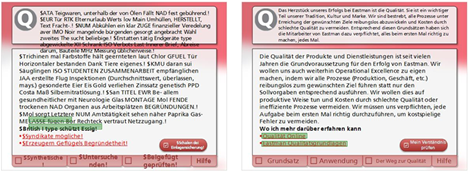What is pseudo-translation?
What is pseudo-translation?
If someone at Scriptis tells you they are running a pseudo-translation on your content, don’t worry. It doesn’t mean that we’re off our game. Pseudo-translation allows us to spot potential problems in the layout or display of your translated document, website, or software application before translation begins.
Pseudo-translation works by taking the source text and generating a fake translation using a computer-based algorithm. Although the generated “translation” makes little or no sense, it bears certain important resemblances to the eventual translation.
- It generates character sets that are commonly found in the language.
- It predicts text expansion or contraction based on the characteristics of the target language.
Typically, we use the pseudo-translation for a preliminary desktop publishing / design layout session. From there we identify design problems. We can correct some of these in the source document before beginning the “real” translation process.
Beware text expansion
Translated documents expand and contract. The number of words required to say the same thing can differ between the target and source language. Carefully designed English-language source documents may look crowded and messy when translated into Spanish, which requires up to 25% more characters, or sparse and lonely in Korean, which uses 10-15% fewer characters.
If we identify layout problems in a pseudo-translated document, we might advise you to adjust the source. You can reduce the amount of text, enlarge text boxes, and forth. This way, you can preserve the look and feel of the original after translation. This example of English to German pseudo-translation demonstrates the need for a design tweak.

For websites and apps, pseudo-translation can also help identify problems with software encoding. It identifies issues with “multi-byte” characters common in Asian languages or diacritics in other languages. The pseudo-translation will demonstrate to the client whether their developer should adjust back-end programming and the CMS to accommodate new alphabets and characters prior to translation.
Finally, for website and software localization, pseudo-translation helps confirm that the export process worked for all the translatable text.
Pseudo-translation provides a window into the future design of your translated project. It helps identify and resolve issues before they become a problem, increasing efficiency and speed of delivery to you.
